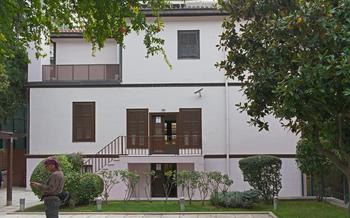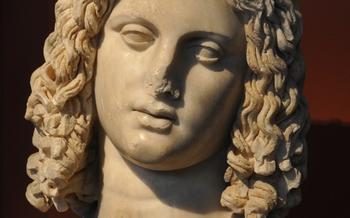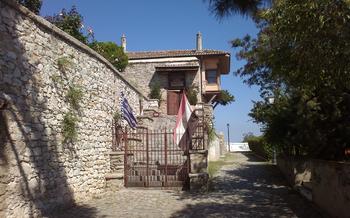
Atatürk's House
- Atatürk's House in Thessaloniki
- Location and Transportation
- History of Atatürk's House
- Architectural Style
- Interior of the Museum
- Exhibits and Displays
- Educational Programs
- Significance for Turkish Visitors
- Cultural Exchange
- Visitor Tips
- Timing Your Visit
- Accessibility
- Admission and Fees
- Nearby Attractions
- Insider Tip: Visit the Turkish Consulate for Deeper Insights
Atatürk's House in Thessaloniki
Mustafa Kemal Atatürk, the revered founder of the Turkish Republic, spent his formative years in the vibrant city of Thessaloniki, Greece. His family home, now known as Atatürk's House, stands as a testament to his early life and the rich history of the region. Built in the late 19th century, this modest yet significant residence showcases a unique blend of Ottoman and European architectural influences, reflecting Thessaloniki's diverse cultural heritage. Today, Atatürk's House serves as a museum, inviting visitors to delve into the life and legacy of this extraordinary figure. Guided tours, led by knowledgeable experts, provide a deeper understanding of Atatürk's childhood, his family life, and his role in shaping modern Turkey.
Location and Transportation
Atatürk's House is conveniently situated in the heart of Thessaloniki, at Apostolou Pavlou 3Its central location makes it easily accessible by various means of transportation.
How to Get There:
On Foot: If you're exploring Thessaloniki's city center, you can easily reach Atatürk's House by foot. It's within walking distance from popular landmarks like the White Tower and Aristotelous Square.
Public Transportation: Thessaloniki's efficient public transportation system connects various parts of the city. You can hop on bus lines 1, 2, 3, 4, 5, 6, 7, 8, 9, 10, 11, 12, 13, 15, 23, 31, 33, 45, 50, or 54 to reach the "Apostolos Pavlos" bus stop, located just a short walk from the museum.
Taxi: Taxis are readily available in Thessaloniki, and they can take you directly to Atatürk's House. Simply provide the address to the driver.
Parking Availability:
Limited street parking is available in the vicinity of Atatürk's House. However, it's advisable to use public transportation or taxis, especially during peak tourist season, to avoid the hassle of finding a parking spot.
History of Atatürk's House
Growing up in Thessaloniki during the late 19th century, Mustafa Kemal Atatürk's early life was deeply intertwined with the city's vibrant cultural and political landscape. Atatürk, born Ali Rıza oğlu Mustafa, spent his formative years in this house, which served as his family's residence. It was here that he developed a deep understanding of the diverse cultural influences that shaped his hometown, from the Ottoman Empire's legacy to the aspirations of the Greek War of Independence. These early experiences in Thessaloniki laid the foundation for Atatürk's future role as a transformative leader in modern Turkey.
Thessaloniki, a city with a rich and complex history, was a melting pot of different cultures and communities. Atatürk's family home was located in the heart of this vibrant urban environment, allowing him to witness firsthand the challenges and opportunities that defined the era. The city's strategic location, as a gateway between the East and West, exposed Atatürk to diverse perspectives and ideas that would later shape his vision for a modern, secular, and progressive Turkey.
The house itself, a modest yet elegant dwelling, served as a witness to Atatürk's childhood and adolescence. It was within these walls that he received his early education, nurtured his intellectual curiosity, and formed lasting friendships that would shape his future path. The presence of Atatürk's family home in Thessaloniki is a poignant reminder of his deep connection to the city and the pivotal role it played in his personal and political development.
Architectural Style
The architectural style of Atatürk's House is a blend of Ottoman and European elements, reflecting the cosmopolitan nature of Thessaloniki in the 19th century. The house features traditional Ottoman architectural elements such as overhanging eaves and bay windows, combined with European influences seen in the symmetrical facade and the use of decorative moldings. The building's red-tiled roof and whitewashed walls are typical of 19th-century Thessaloniki architecture, creating a striking visual contrast against the city's backdrop.
Extensive restoration and preservation efforts have been undertaken to maintain the house's original character. The restoration process involved meticulous attention to detail, ensuring that the house's architectural features and historical integrity were preserved. As a result, visitors to the museum can experience the building's historical charm and appreciate its unique architectural fusion.
Interior of the Museum
The interior of Atatürk's House has been meticulously restored to its original state and now serves as a museum dedicated to the life and achievements of Mustafa Kemal Atatürk. Visitors can explore the various rooms of the house and gain a glimpse into Atatürk's childhood and family life. Original furnishings and personal belongings, such as his bed, desk, and clothing, are on display, providing a tangible connection to his past.
In addition to the original furnishings, the museum also houses a collection of historical artifacts and documents related to Atatürk's life and career. These include photographs, letters, and official documents that shed light on his role in the Turkish War of Independence and the founding of the Turkish Republic. Visitors can also view a recreation of Atatürk's childhood memories, offering a unique perspective on his formative years in Thessaloniki.
The museum's exhibits are designed to be both informative and engaging, allowing visitors to learn about Atatürk's life and legacy in a comprehensive and interactive way. Through carefully curated displays and multimedia presentations, the museum provides a comprehensive overview of Atatürk's contributions to Turkey and his enduring impact on the nation's history and culture.
Exhibits and Displays
Atatürk's House Museum offers a captivating journey through the life and achievements of Mustafa Kemal Atatürk, the revered founder of modern Turkey. Interactive exhibits bring to life the various chapters of his extraordinary journey, from his early years in Thessaloniki to his pivotal role in shaping the course of Turkish history.
The museum's displays are designed to engage visitors of all ages and backgrounds. Multimedia presentations, touch screens, and immersive dioramas provide a multisensory experience that transports visitors back in time. Thematic displays delve into the rich history and culture of Turkey, shedding light on Atatürk's vision for a modern, secular, and progressive nation.
Temporary exhibitions and special events add a dynamic element to the museum's offerings. These events showcase the latest research on Atatürk's life and legacy, as well as contemporary Turkish art and culture. Visitors can attend lectures, workshops, and film screenings to deepen their understanding of Turkey's past and present.
Educational Programs
Atatürk's House in Thessaloniki is not merely a museum; it also serves as an educational and cultural hub. The museum offers a range of educational programs designed to promote Turkish history and culture to visitors of all ages. These programs include:
-
Workshops and Lectures: The museum regularly hosts workshops and lectures conducted by experts in Turkish history, culture, and art. These events provide a platform for learning and discussion, allowing visitors to delve deeper into the life and accomplishments of Atatürk and the broader history of Turkey.
-
School Visits and Group Tours: The museum welcomes school groups and organized tours, providing tailored guided tours and interactive activities tailored to the curriculum. These educational tours offer an opportunity for students to learn about Turkish history, culture, and Atatürk's legacy in a hands-on and engaging manner.
-
Collaborations with Local Universities and Institutions: The museum actively collaborates with local universities and institutions to promote academic research and educational initiatives related to Turkish history and culture. These partnerships facilitate joint projects, seminars, and conferences, contributing to the dissemination of knowledge and understanding between Turkey and Greece.
Significance for Turkish Visitors
For Turkish visitors, the Atatürk House holds profound significance beyond its historical and architectural value. It is a revered pilgrimage site, where Turks from all walks of life come to pay homage to the father of modern Turkey. The house represents a tangible connection to Atatürk's legacy and serves as a symbol of national pride and heritage. It offers an opportunity for Turkish people to immerse themselves in the life and achievements of one of their most influential leaders, gaining a deeper understanding of his vision for Turkey's transformation. By visiting the Atatürk House, Turkish visitors can strengthen their sense of national identity and connect with the roots of their modern nation.
Cultural Exchange
Atatürk's House in Thessaloniki serves as a vital bridge for cultural exchange between Turkey and Greece. It's an opportunity for visitors to delve into Turkish history, culture, and traditions, fostering understanding and friendship between the two neighboring countries. Through its exhibits and educational programs, the museum promotes Turkish heritage and contributes to intercultural dialogue and cooperation.
The museum's presence in Thessaloniki, a city with a rich multicultural past, facilitates the exchange of ideas and perspectives between different cultures. It encourages Greek visitors to learn more about Turkey, breaking down stereotypes and promoting mutual respect. At the same time, it allows Turkish visitors to discover the shared history between the two countries, fostering a sense of unity and common ground.
By hosting temporary exhibitions, special events, and collaborations with local institutions, Atatürk's House becomes a platform for cultural exchange and dialogue. These events not only showcase Turkish culture but also invite Greek participation and collaboration, creating a space for meaningful interactions and the celebration of diversity.
In essence, Atatürk's House in Thessaloniki transcends its role as a museum, becoming a symbol of cultural exchange and cooperation between Turkey and Greece. It serves as a reminder of the rich history and shared heritage that bind the two countries, promoting understanding, friendship, and intercultural dialogue.
Visitor Tips
To make the most of your visit to Atatürk's House, here are some practical tips to keep in mind:
-
Plan your visit during the off-season (November to March) to avoid the crowds and enjoy a more intimate experience.
-
Photography is allowed inside the museum, so bring your camera to capture the unique architecture and exhibits.
-
Guided tours are highly recommended for a deeper understanding of Atatürk's life and the history of the house. Tours are available in multiple languages and provide valuable insights into the significance of this site.
-
Check the museum's website before your visit to stay updated on special events, temporary exhibitions, and any changes in operating hours.
Timing Your Visit
Plan your visit to the Atatürk House during the off-season (October to April) to avoid the summer crowds and enjoy a more tranquil experience. The museum is open every day of the week, except for major Greek holidays like Christmas, Easter, and Independence Day. It is advisable to arrive early in the morning or late in the afternoon to avoid the midday heat, especially during the summer months. If you prefer a more personalized experience, consider booking a guided tour, as they provide a deeper understanding of Atatürk's life and the history of the house. Check the museum's official website for the most up-to-date information on opening hours, special events, and temporary exhibitions.
Accessibility
The Atatürk's House Museum is committed to providing an accessible and inclusive experience for all visitors. Wheelchair users and individuals with limited mobility can easily navigate the museum's ground floor, which features the main exhibition halls and a gift shop. Accessible restrooms are also available on this level.
For visitors with visual impairments, guided tours with audio descriptions are offered upon request. Assisted listening devices are available for those who need amplification during guided tours or presentations. Additionally, tactile exhibits and Braille signage are incorporated throughout the museum to enhance the experience for visitors with visual disabilities.
The museum staff is trained to assist visitors with disabilities and ensure that they have a comfortable and enjoyable visit. Visitors with specific accessibility needs are encouraged to contact the museum in advance to make arrangements for any necessary accommodations.
Admission and Fees
Visiting Atatürk's House in Thessaloniki is an affordable and accessible experience. The entrance ticket prices are set to encourage cultural exploration and education. Standard admission fees apply, with discounts offered to students, seniors, and families. These concessions make the museum accessible to a wide range of visitors, promoting inclusivity and ensuring that everyone has the opportunity to immerse themselves in Turkish history and culture. It's worth noting that the museum offers free admission on certain days or for specific groups, such as students on school trips or visitors with disabilities. These initiatives demonstrate the museum's commitment to fostering cultural exchange and making Atatürk's legacy accessible to all.
Nearby Attractions
The Atatürk House is situated in the heart of Thessaloniki, a city brimming with historical and cultural treasures. Take advantage of your visit to explore other fascinating attractions in the vicinity. Stroll through the ancient ruins of the Roman Forum and marvel at the awe-inspiring Arch of Galerius. Immerse yourself in the poignant history of the Jewish Museum of Thessaloniki, paying tribute to the city's once-thriving Jewish community. For a taste of modern Greek culture, visit the Thessaloniki Concert Hall, renowned for its world-class performances and exhibitions. Indulge in the city's vibrant culinary scene at one of the many restaurants and cafes lining the picturesque streets. With so much to see and do, Thessaloniki offers an unforgettable urban experience for every traveler.
Insider Tip: Visit the Turkish Consulate for Deeper Insights
For an even more comprehensive understanding of Atatürk's life and legacy, make sure to visit the Turkish Consulate located just a short distance from his house. The consulate staff is knowledgeable and welcoming, and they can provide you with additional information and resources on Atatürk and Turkish history. They may also be able to arrange for a guided tour of the consulate building, which houses various artifacts and exhibits related to Atatürk's time in Thessaloniki. By visiting both Atatürk's House and the Turkish Consulate, you will gain a deeper appreciation for the man who shaped the course of modern Turkey and his enduring impact on the region.




